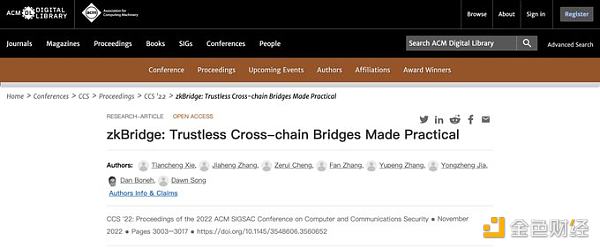Author: BMAN, Source: Author's Twitter @BMANLead
Recently, the three giants of interoperability have been launched one after another. The Indian summer that set off the interoperability track.
@PolyhedraZK $ZK will be online in March; @wormholecrypto $W will be online in April; @LayerZero_Labs is expected to be online in Q2.
Polyhedra is the only ZK player among them. It also grabbed the beautiful $ZK Ticker, completed a US$1 billion financing led by Polychain, and became a veritable ZK player. Interoperability leader.
In the past three years, more than 20 PhDs and cryptography experts from the Polyhedra team have made dozens of breakthroughs around ZK interoperability. DeVirgo and Virgo invented by Polyhedra are One of the fastest ZKP protocols currently available. Ordinary users using laptops or mobile phones can become Prover without downloading large amounts of data from the server (which is well known to be a problem in the industry).
deVirgo has near-perfect linear scalability, proving that the generation time can be shortened by nearly M times in a distributed computing network with M computers. Furthermore, in deVirgo, communication across distributed computing networks is minimized in the main computation (GKR part) in Virgo. Using deVirgo, zkBridge's proof generation speed can be further improved, 100 times faster than using single-threaded Virgo.
In the past three years, Polyhedra has made three important technological breakthroughs based on zk:
1. zkBridge and zkLightClient
Polyhedra invented the industry's first zkBridge. zkBridge was born out of the 2022 ACM CCS paper at the top network security conference. The guiding professor is a U.S. national Academician of the Academy of Sciences. Dan Boneh, chief scientist of A16z Crypto and cryptography technical consultant of Vitailk:
https://dl.acm.org/doi/10.1145/3548606.3560652…

On-chain users have sent more than 20 million cross-chain transactions through zkBridge in millions of wallets, 25 chains and more than 80 ecosystems in the past 3 years.
The ZK light client zkLightClient invented by Polyhedra also provides more than 4.5 million message transmission for Layer1 and Layer2 interoperation. LayerZero, one of the three interoperability giants, is also using zkLightClient as the default decentralized verification network (DVN).
2. Ethereum full node certification:
Polyhedra uses ZK to enhance BLS signature verification, Significantly reduces the communication size between Ethereum validators and full nodes. This innovative enhancement paves the way for Ethereum to be more streamlined and scalable. The zk light client zkLightClient enables every validator to sign every block, allowing a single zk-proof to verify 512 BLS signatures, requiring only 200 to 300 Bytes of communication.
The single-slot finality (SSF) created by Polyhedra also significantly reduces Ethereum's latency. It is combined with the advanced ZKP deVirgo and improved signature scheme to enhance the speed and user experience of Ethereum. It is also one of Vitalik's most valued Ethereum milestones.
3. Bitcoin interoperability:
In the early stages of development, the Bitcoin ecosystem has already There are dozens of Layer 2 players vying for the top spot, but dozens of Layer 2 players are also in urgent need of interoperable infrastructure. Polyhedra is the leader in the interoperability of the Bitcoin ecosystem.
zkBridge already supports the greatest interoperability of the Bitcoin ecosystem, connecting Bitcoin wallets, Layer 2, DeFi and infrastructure. Even between Bitcoin and other chains, trustless interoperation can be carried out based on ZK.
Conclusion:
In the past 3 years, Polyhedra invented the fastest ZK algorithm deVirgo. Connected to more than 25 networks, completed 40 million zk proofs, 20 million cross-chain transactions, and each transaction only requires 1 message. In comparison, Wormhole requires 1 billion messages to verify a total of 3 million transactions. Polyhedra is currently the most efficient leading interoperability project.
In the next few years, we expect to achieve 1000x performance improvements in mathematics and ZKP, which will enable the vision of fully interoperable blockchains to be realized. In the future, chains will realize:
1. Interoperability of assets;
2. Information interoperation;
3. Protocol interoperation.
In the future, the protocol of chain A can be automatically combined and interoperable with the protocol of chain B, and the chains will become interconnected with thousands of chains. And Polyhedra, like its Chinese "polyhedron", has become the infrastructure for the interconnection of thousands of chains.
 Hui Xin
Hui Xin
 Hui Xin
Hui Xin Bitcoinist
Bitcoinist Coindesk
Coindesk Cryptoknowmics
Cryptoknowmics Beincrypto
Beincrypto